
Photo from wikipedia
The risk from naturally occurring radioactive materials (NORM) has been extensively assessed, and this has led to the integration of specific NORM radiation protection requirements within the latest EU Directive… Click to show full abstract
The risk from naturally occurring radioactive materials (NORM) has been extensively assessed, and this has led to the integration of specific NORM radiation protection requirements within the latest EU Directive 2013/59. Nevertheless, it has been internationally recognised that remaining NORM knowledge gaps and uncertainties now present similarly significant issues in addressing recent regulatory requirements. The multi-tiered nature of environmental impact assessment (EIA) implies per se possibility for uncertainties, but when EIA at radiation exposure sites includes consideration of sites with multiple radiation and contamination sources, different ecosystem transport pathways, effects and risks by applying different parameters and models, level of overall uncertainty increases. The results of EIA study in the Fen area in Norway, comprised of undisturbed and legacy NORM sites, have been evaluated in this analysis, in order to identify all existing input uncertainties and how they may impact the final conclusions, and thus, influence any subsequent decision-making. The main uncertainties have been identified in the measurement and exposure analysis tier, and were related to the heterogeneous distribution of radionuclides, radionuclide speciation, as well as to generic variability issues in the concepts used for mobility and biota uptake analysis (such as distribution coefficient, transfer factors and concentration ratios) as well as radioecological modelling. The uncertainties in the input values to the calculation of the dose arising from radon exposure in the Fen area led to an overall elevated uncertainty of the magnitude of the radiation exposure dose of humans. It has been concluded that an integrated, ecosystem-based approach with consideration of complexity of prevailing environmental conditions and interconnections must be applied to fully understand possible radiation effects and risks.
Journal Title: Environmental Monitoring and Assessment
Year Published: 2020
Link to full text (if available)
Share on Social Media: Sign Up to like & get
recommendations!